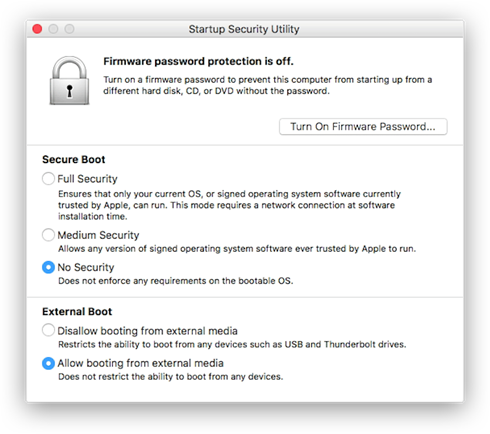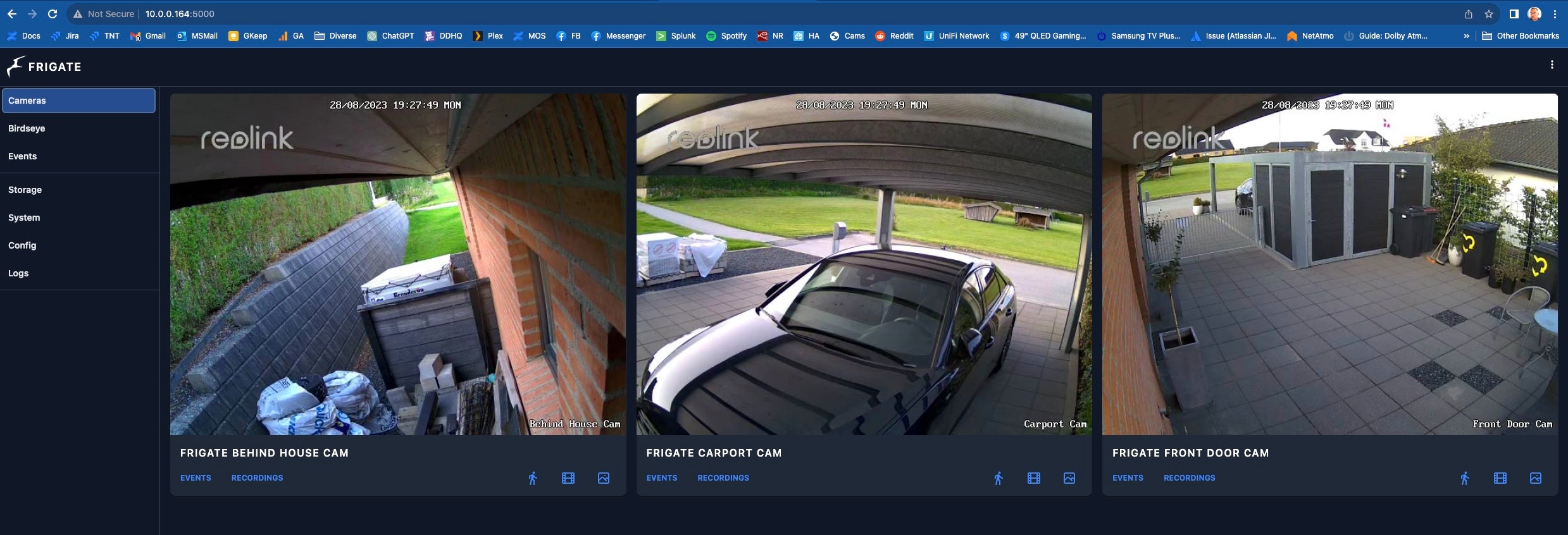So, I purchased an older MacBook from work - that has been my own for 4 year, and was specced well with SSD.
Preparing the Firmware/T2
I has some problems with removing activation lock and even do an Internet recovery. but when the MACOS was cleanly installed, make sure to enable USB Boot, as this:
Installing Ubuntu
I had a lot of trouble actually getting the danm thing to boot, but on a stick with Ubuntu 22.04, it finally did.
But, the Mac Keyboard was not working, but I got hold of an eternal keyboard - and that worked.
I had a lot of problemes getting to use the disk, several times the installer just crashed and restarted, and stopped with "Intallaling grub on taget device failed"
But I finally gut the installer to remove all partitions and install, with "Use customer partitions" - make sure to whipe and erasa all on the disk.
After the install af "df -h" told me that only 100 GB of the disk was used - I have no clue why..
But the fix - first examine:
root@beetle:/home/bnp# vgdisplay --- Volume group --- VG Name ubuntu-vg System ID Format lvm2 Metadata Areas 1 Metadata Sequence No 2 VG Access read/write VG Status resizable MAX LV 0 Cur LV 1 Open LV 1 Max PV 0 Cur PV 1 Act PV 1 VG Size <462.87 GiB PE Size 4.00 MiB Total PE 118494 Alloc PE / Size 25600 / 100.00 GiB Free PE / Size 92894 / <362.87 GiB VG UUID Dd5nRh-qzsj-z6rX-H1o1-JzMd-kXEI-7bWoEx root@beetle:/home/bnp# vgdisplay --- Volume group --- VG Name ubuntu-vg System ID Format lvm2 Metadata Areas 1 Metadata Sequence No 4 VG Access read/write VG Status resizable MAX LV 0 Cur LV 1 Open LV 1 Max PV 0 Cur PV 1 Act PV 1 VG Size <462.87 GiB PE Size 4.00 MiB Total PE 118494 Alloc PE / Size 118494 / <462.87 GiB Free PE / Size 0 / 0 VG UUID Dd5nRh-qzsj-z6rX-H1o1-JzMd-kXEI-7bWoEx
The import part being:
Free PE / Size 92894 / <362.87 GiB
So, 362 GB not used.
Lets extend and resize:
lvextend -l +100%FREE /dev/mapper/ubuntu--vg-ubuntu--lv resize2fs /dev/mapper/ubuntu--vg-ubuntu--lv
Now, we can see 0 Free PE:
root@beetle:/home/bnp# vgdisplay --- Volume group --- VG Name ubuntu-vg System ID Format lvm2 Metadata Areas 1 Metadata Sequence No 4 VG Access read/write VG Status resizable MAX LV 0 Cur LV 1 Open LV 1 Max PV 0 Cur PV 1 Act PV 1 VG Size <462.87 GiB PE Size 4.00 MiB Total PE 118494 Alloc PE / Size 118494 / <462.87 GiB Free PE / Size 0 / 0 VG UUID Dd5nRh-qzsj-z6rX-H1o1-JzMd-kXEI-7bWoEx
Ubuntu is installed and the complete SSD Disk installed.
Docker install
Lets install docker.io:
apt install docker.io
Frigate NVR Install
First, I put all docker stuff in /opt
the:
mkdir /opt/frigate vi /opt/frigate/config
The config file can be huge, here is my current:
mqtt:
host: 10.0.0.183
cameras:
frigate_front_door_cam:
ffmpeg:
inputs:
- path: rtsp://view:**********@10.0.0.151:554//h264Preview_01_sub
roles:
- detect
- path: rtsp://view:**********@@10.0.0.151:554//h264Preview_01_main
roles:
- record
rtmp:
enabled: False
detect:
width: 640
height: 480
fps: 5
objects:
track:
- person
snapshots:
enabled: True
timestamp: false
bounding_box: True
retain:
default: 2
record:
enabled: True
events:
retain:
default: 10
frigate_behind_house_cam:
ffmpeg:
inputs:
- path: rtsp://view:**********@@10.0.0.176:554//h264Preview_01_sub
roles:
- detect
- path: rtsp://view:**********@@10.0.0.176:554//h264Preview_01_main
roles:
- record
rtmp:
enabled: False
detect:
width: 640
height: 480
fps: 5
objects:
track:
- person
snapshots:
enabled: True
timestamp: false
bounding_box: True
retain:
default: 2
record:
enabled: True
events:
retain:
default: 10
frigate_carport_cam:
ffmpeg:
inputs:
- path: rtsp://view:**********@@10.0.0.191:554//h264Preview_01_sub
roles:
- detect
- path: rtsp://view:**********@@10.0.0.191:554//h264Preview_01_main
roles:
- record
rtmp:
enabled: False
detect:
width: 640
height: 480
fps: 5
objects:
track:
- person
- car
snapshots:
enabled: True
timestamp: false
bounding_box: True
retain:
default: 2
record:
enabled: True
events:
retain:
default: 10
detectors:
coral:
type: edgetpu
device: usb
birdseye:
enabled: True
mode: continuous
In short, the file sets up three cams (Reolink) - using:
- The Lowres RTSP stream for the Detect role
- The highres RTSP stream for the Recording Role
- The tracking of persons and cars
- The use of a Coral stick for Object processing.
And the database file /opt/frigate/frigate.yml
codedatabase: path: /opt/frigate/frigate.db
Now we can start Frigate:
docker run -d \ --name frigate \ --restart always \ --mount type=tmpfs,target=/tmp/cache,tmpfs-size=1000000000 \ --device /dev/bus/usb:/dev/bus/usb \ --shm-size=256m \ -v /opt/frigate/media:/media/frigate \ -v /opt/frigate/config.yml:/config/config.yml:ro \ -v /etc/localtime:/etc/localtime:ro \ -e FRIGATE_RTSP_PASSWORD='**********' \ -p 5000:5000 \ -p 1935:1935 \ ghcr.io/blakeblackshear/frigate:master-433bf69-tensorrt
This should start Frigate and show it on http://10.0.0.164:5000:
sudo apt-get install gasket-dkms libedgetpu1-std
root@beetle:/home/bnp# lsusb
Bus 002 Device 001: ID 1d6b:0003 Linux Foundation 3.0 root hub
Bus 001 Device 003: ID 05ac:1463 Apple, Inc. USB-C Digital AV Multiport Adapter
Bus 001 Device 002: ID 05ac:1017 Apple, Inc. USB2.0 Hub
Bus 001 Device 001: ID 1d6b:0002 Linux Foundation 2.0 root hub
Bus 006 Device 003: ID 1a6e:089a Global Unichip Corp.
Bus 006 Device 002: ID 05ac:1018 Apple, Inc. USB3.1 Hub
Bus 006 Device 001: ID 1d6b:0003 Linux Foundation 3.0 root hub
Bus 005 Device 001: ID 1d6b:0002 Linux Foundation 2.0 root hub
Bus 004 Device 002: ID 0bda:8153 Realtek Semiconductor Corp. RTL8153 Gigabit Ethernet Adapter
Bus 004 Device 001: ID 1d6b:0003 Linux Foundation 3.0 root hub
Bus 003 Device 001: ID 1d6b:0002 Linux Foundation 2.0 root hub
root@beetle:/home/bnp# lsusb | grep Goole
root@beetle:/home/bnp# lsusb | grep Google
root@beetle:/home/bnp# lspci -nn | grep 089a
root@beetle:/home/bnp#

